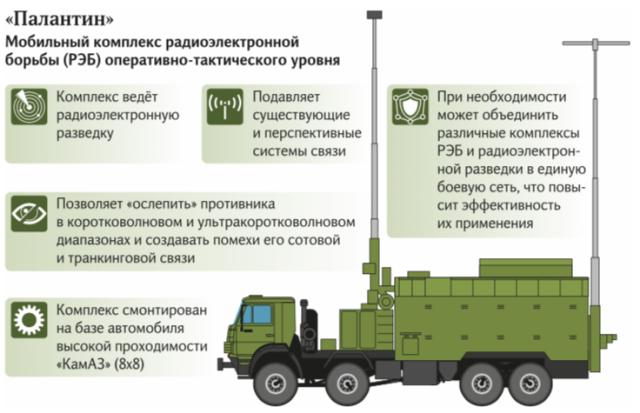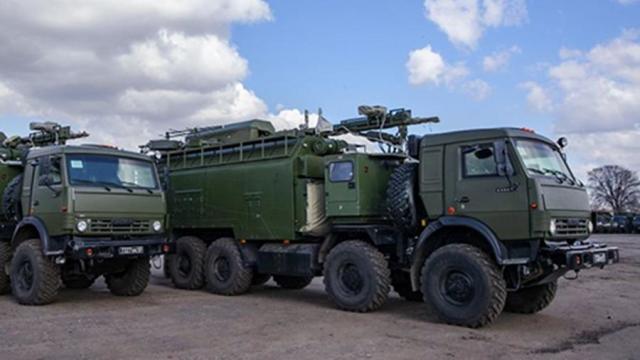The southern military district will be equipped with one of the most effective and multifunctional electronic warfare stations. The latest "Palantin" complex is capable of suppressing not only cellular and radio communications, but also control channels for drones. Freely sold in stores or assembled from available parts, UAVS have already proven to be a dangerous weapon in the hands of terrorists. The complex will also be able to combine other electronic warfare tools into a single network, making them more efficient. According to experts, such systems are defensive weapons.
The southern military district will be equipped with one of the most effective and multifunctional electronic warfare stations. The latest "Palantin" complex is capable of suppressing not only cellular and radio communications, but also control channels for drones. Freely sold in stores or assembled from available parts, UAVS have already proven to be a dangerous weapon in the hands of terrorists. The complex will also be able to combine other electronic warfare tools into a single network, making them more efficient. According to experts, such systems are defensive weapons.
Strategic direction
A fundamental decision was made to equip all army EW battalions in the southern military district with the latest "Palantin" complexes, sources in the defense Ministry told Izvestia. They are designed to suppress military radio communications and drones, including small ones. Their versatility also allows them to jam radio relay stations and satellite ground terminals.
 |
| EW complex "Palantin". |
| Source: iz.ru |
According to the press service of the Ministry of defense, the "Palantin" was first tested a year ago at an exercise near Voronezh. The battalion tactical EW group used it to train to suppress communications in a band of up to 1,000 km and protect troops from the use of high-precision weapons of a simulated enemy.
As previously reported by Izvestia, other modern electronic warfare systems are also being delivered to the southern military district. So, in the near future, it is planned to transport additional Mi-8MTPR-1 electronic warfare helicopters with the Rychag-AV system. They are designed to cover aircraft from enemy radars and protect against anti-aircraft and aircraft missiles.
— It is no secret that the "Palantin" was created, first of all, to counter the latest military communication systems of NATO, - military expert Vladislav Shurygin told Izvestia. — But the complex turned out to be so versatile that it can perform other tasks. Especially in demand will be its ability to "drown out" drones of any class.
Saturation of the southern military district with the latest electronic warfare equipment is not surprising, the expert believes. This is where Russia's interests clash most with the West, as well as with post-Soviet States. It is enough to name Crimea, Abkhazia and South Ossetia. At the same time, electronic warfare means are defensive weapons and do not pose an immediate threat, Vladislav Shurygin stressed.
Intelligent suppressor
The latest "Stoles" are coming to the troops in 2018. The mobile complex is located on several four-axle chassis of the KAMAZ truck. From the transport position to the combat position, it can be deployed in half an hour.
According to the developers, the machine can "clog" the cellular and trunking communication channels with interference, and muffle the enemy's tactical radio communication in the range of ultrashort and short waves. The most important feature of the complex is the ability to effectively act against modern and promising radio stations that are able to flexibly change their frequencies and operating algorithms — the so-called software-defined radio systems (SDR). Older electronic warfare systems cannot effectively counteract them.
Equipment and new software "Palantinov" allows you to receive and integrate information from various means of electronic warfare and radio intelligence and transmit it to higher headquarters. As a result, they can monitor the situation on the airwaves online and make a decision on the synchronized use of various electronic warfare machines.
According to the Ministry of defense, the system can operate both in broadband mode and put targeted interference for specific directions and characteristics of the radio signal, which allows it to work in a variety of conditions. You can suppress an entire area, or counteract a specific transmitter or receiver.
The machine combines the functions of radio intelligence and radio suppression. For example, by studying the radio broadcast, it can not only detect the presence of a drone nearby, but also calculate the approximate coordinates of its operator, and then mute the control signal between it and the drone, making the device helpless.
First of all, the complexes presented in 2016 were received by the Tambov Interspecific center for training and combat use of electronic warfare. In 2019, they entered the 24th separate EW battalion of the Western military district, which became a pilot in their development. It was also reported about plans to equip one of the electronic warfare units of the Eastern military district in Transbaikalia with "Palantin" by the end of this year.
Small drones are big problems
- Electronic warfare equipment with the capabilities of the "Palantin" is an important element of protection against drones, - says military historian Dmitry Boltenkov. — The war in Karabakh has brought the problem of fighting them to a new level. Today, even countries that are not the most advanced in military equipment can have a fleet of the most dangerous attack UAVS and small kamikaze drones. It is difficult, if not impossible, to counteract them with outdated weapons.
But now the danger is not only military models. Freely sold in stores or assembled from available parts, UAVS have already proven to be dangerous weapons. In Iraq and Syria, the terrorist group "ISIL" (banned in Russia) widely used dozens of inexpensive Chinese-made quadrocopters to drop small bombs. This was enough to injure and kill military personnel, and in some cases disable armored vehicles, the expert said.
In October 2017, in Syria, by dropping bombs simultaneously from several drones, terrorists managed to cause a fire that destroyed a large-scale ammunition depot of government forces. It was organized by the advancing troops in the bowl of the football stadium near Deir ez-Zor.
The Ministry of defense of the Russian Federation reports that since January 2018, militants with homemade UAV bombers regularly try to break through to the Russian bases of Khmeimim and Tartus in Syria and attack planes and ships located there. The most massive RAID of 13 drones was repelled by joint actions of air defense and electronic warfare. Seven units were shot down by Pantsire missiles, and the rest were forcibly put on the ground by electronic warfare specialists. The Ministry of defense showed the wreckage of these drones at a special briefing.
In the autumn conflict in Karabakh, both Armenia and Azerbaijan used multicopters with explosives suspended on them as unmanned kamikazes to attack infantry concentrations. The Russian defense Ministry reported last year that the" Stoles " during the exercises worked out, among other things, the scenario of suppressing such targets.

